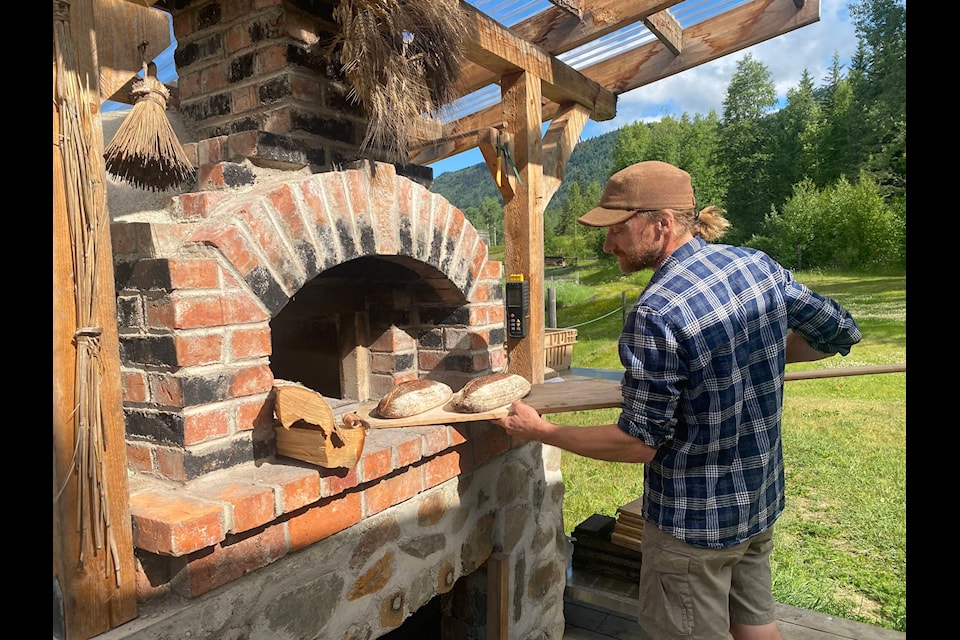Baguettes, buns and croissants are a few of the things baked in the hand-built wood fire oven that sits deep within Kispiox Valley, located between Smithers and Terrace. Here, the coastal air merges with lush forests and the scent of freshly baked bread (could anything smell better?).
A cycling trip to Haida Gwaii led Jonathan Knight to the area after years spent on various farms dreaming of finding his own land. After selling his company, True Grain Bread, in Cowichan Bay, he purchased the northern farm in 2009. Together with his partner, Jolene Swain, they run the certified organic WoodGrain Farm and produce vegetables, seeds, lamb, garlic salts and flour.
The Red Seal-trained baker described their flour production as operating on more of a “hobbyist scale,” although they still sell their flour at the local farmers’ market and to retailers.
Production depends on what works in the marginal climate with short seasons. Knight has seen success with rye and winter wheat—although one winter, it didn’t get cold enough, and a field of winter wheat moulded in the snow. Another year, the grizzly bears were well fed after they got to his spring wheat, red fife.
“It’s best not to put too many eggs in the grain basket here,” he said while explaining that farmers must be resilient and diverse in remote locations.
“You can’t really sell a lot of just a few things. You need to have a great variety of many different things to sell. It’s not like you have a lot more customers come to the market that are just going to each grab a bag of carrots. You have relatively few customers compared to larger centers. So you want to be able to offer more to them.”
As such, being a jack of all trades is important, he said; however, HARVEST didn’t get the impression that he’s a master of none.
Along with the wood fire oven, Knight successfully built the farm’s stone ground flour mill. The 12” quarried granite stone was ordered from Meadows Mills in North Carolina and is beautifully encased in Kispiox birch.
After harvesting his fields, the stone mill sheers the grain, keeping the different parts of the grain together—the bran, germ and endosperm.
This differs from what many commercial mills often use—rollers—that separate the bran and germ from the grain. The bran can be added back afterward, but the germ, the most nutritious part of the grain, is not always added back because it shortens the flour’s shelf life.
While Health Canada requires the nutrients lost during commercial processing to be added to the flour, Knight says that, unless stone ground, it’s technically not 100 per cent whole wheat flour; it’s refined flour with bran re-added.
For Knight, he prefers the traditional method. Keeping the grain intact also helps maintain the nutrition and flavour.
“All you should need to make bread is flour, water and a bit of salt to sort of enhance the flavours.”
His collection of up to 40 heirloom seed varieties allows him to experiment and see what does best: the older varieties that contain genetic diversity in them.
“When you’re growing [wheat] and saving the seeds and growing [wheat] and saving the seeds, you’re saving the best ones, the best individuals in that population. So they’re gradually changing and adapting to your climate … you know, the somewhat cool, somewhat short season of the northwest B.C. climate.”
While WoodGrain Farm sells its flour, they reserve the bread for them.
“We fire [the oven] up a couple of times a month and we bake all of our bread,” including buns, croissants and baguettes. Next, the products are stored in the freezer for the couple to consume when ready.
“It’s just like having fresh, wood-fired bread every time we pull it from the freezer,” said Knight, who also enjoys hosting pizza parties for friends.
To learn more about WoodGrain Farm, visit their website at woodgrain.ca.
kim.kimberlin@blackpress.ca
Like us on and follow us on



